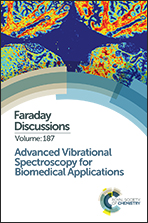Non-invasive chemically specific measurement of subsurface temperature in biological tissues using surface-enhanced spatially offset Raman spectroscopy
Abstract
Here we demonstrate for the first time the viability of characterising non-invasively the subsurface temperature of SERS nanoparticles embedded within biological tissues using spatially offset Raman spectroscopy (SORS). The proposed analytical method (T-SESORS) is applicable in general to diffusely scattering (turbid) media and features high sensitivity and high chemical selectivity. The method relies on monitoring the Stokes and anti-Stokes bands of SERS nanoparticles in depth using SORS. The approach has been conceptually demonstrated using a SORS variant, transmission Raman spectroscopy (TRS), by measuring subsurface temperatures within a slab of porcine tissue (5 mm thick). Root-mean-square errors (RMSEs) of 0.20 °C were achieved when measuring temperatures over ranges between 25 and 44 °C. This unique capability complements the array of existing, predominantly surface-based, temperature monitoring techniques. It expands on a previously demonstrated SORS temperature monitoring capability by adding extra sensitivity stemming from SERS to low concentration analytes. The technique paves the way for a wide range of applications including subsurface, chemical-specific, non-invasive temperature analysis within turbid translucent media including: the human body, subsurface monitoring of chemical (e.g. catalytic) processes in manufacture quality and process control and research. Additionally, the method opens prospects for control of thermal treatment of cancer in vivo with direct non-invasive feedback on the temperature of mediating plasmonic nanoparticles.
- This article is part of the themed collection: Advanced Vibrational Spectroscopy for Biomedical Applications

 Please wait while we load your content...
Please wait while we load your content...